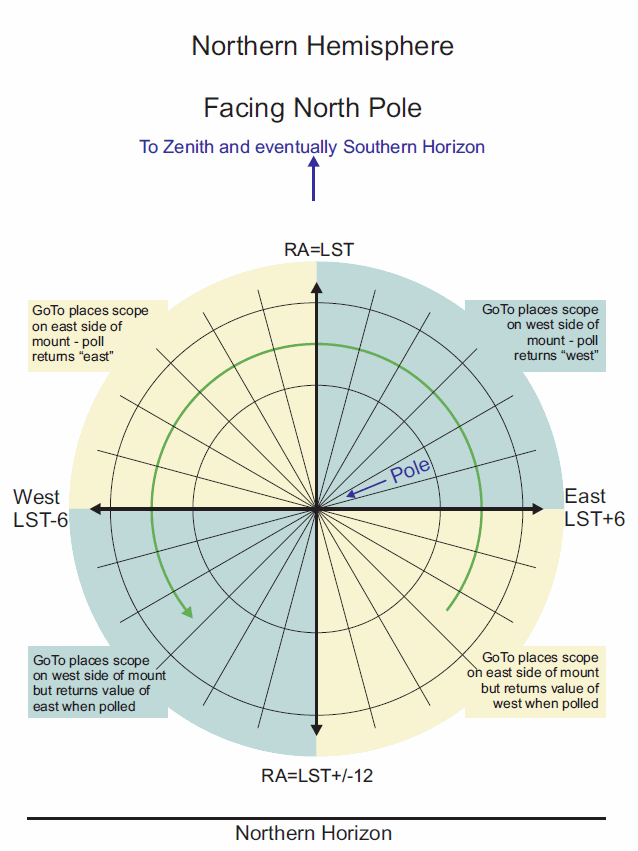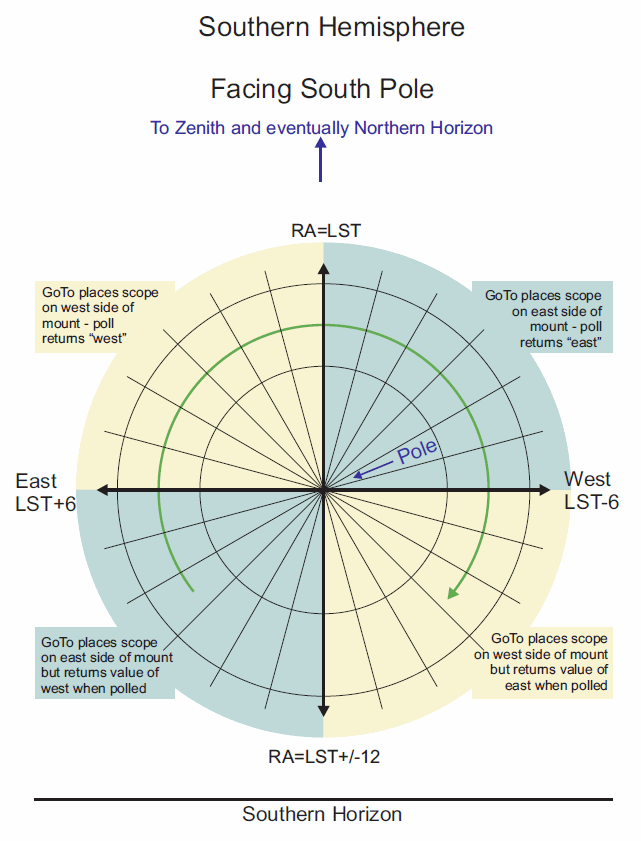Pier Side
For historical reasons, this property's name does not reflect its true meaning. The name will not be changed (so as to preserve compatibility), but the meaning has since become clear. In a future version of the ASCOM standard, a synonym for this property will be added which better describes its meaning.
All conventional mounts have two pointing states for a given equatorial (sky) position. Mechanical limitations often make it impossible for the mount to position the optics at given HA/Dec in one of the two pointing states, but there are places where the same point can be reached in both pointing states (e.g., near the pole). In order to understand these pointing states, consider the following (thanks to Patrick Wallace for this info):
•All conventional telescope mounts have two axes nominally at right angles. For an equatorial, the longitude axis is mechanical hour angle and the latitude axis is mechanical declination.
•Sky coordinates and mechanical coordinates are two completely separate arenas. This becomes rather more obvious if your mount is an altaz, but it's still true for an equatorial.
•Both mount axes can in principle move over a range of 360 deg. This is distinct from sky HA/Dec, where Dec is limited to a 180 deg range (+90 to -90).
•Apart from practical limitations, any point in the sky can be seen in two mechanical orientations. To get from one to the other the HA axis is moved 180 deg and the Dec axis is moved through the pole a distance twice the sky codeclination (90 - sky declination).
•Mechanical zero HA/Dec is one of the two ways of pointing at the intersection of the celestial equator and the local meridian. Choose one, and once you're there, consider the two mechanical encoders zeroed.
•The two states are, then, (a) "normal", where the mechanical Dec is in the range ± 90 deg, and (b) "beyond the pole", where the mechanical Dec is outside that range.
•"Side of pier" is a *consequence* of the former definition, not something fundamental. Apart from mechanical interference, the telescope can move from one side of the pier to the other without the mechanical Dec having changed: you could track Polaris forever with the telescope moving from west of pier to east of pier or vice versa every 12h. Thus, SideOfPier is, in general, not a useful term (except perhaps in a loose, descriptive, explanatory sense).
•All this applies to a fork mount just as much as to a GEM, and it would be wrong to make the "beyond pole" state illegal for the former. You may not be able to get there if your camera hits the fork, but it's possible on some mounts. Whether this is useful depends on whether you're in Hawaii or Finland.
To first order, the relationship between sky and mechanical HA/Dec is as follows:
Normal state:
HA_sky = HA_mech
Dec_sky = Dec_mech
Beyond the pole
HA_sky = HA_mech + 12h, expressed in range ± 12h
Dec_sky = 180d - Dec_mech, expressed in range ± 90d
Astronomy software often needs to know which "side of the pier" (which pointing state) the mount is in. Examples include setting guiding polarities and calculating dome opening azimuth/altitude.
The meaning of SideOfPier, then is:
pierEast - Normal pointing state
pierWest - Beyond the pole pointing state
If the mount hardware reports neither the true pointing state (or equivalent) nor the mechanical declination axis position (which varies from -180 to +180), a driver cannot calculate the pointing state, and *must not* implement SideOfPier.
If the mount hardware reports only the mechanical declination axis position (-180 to +180) then a driver can calculate SideOfPier as follows:
pierEast = abs(mechanical dec) <= 90 deg
pierWest = abs(mechanical Dec) > 90 deg
Here are pictures of the pier side value returned by the mount for the Northern and Southern Hemispheres:


